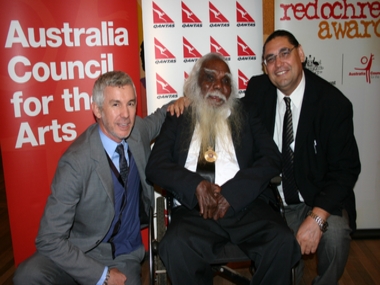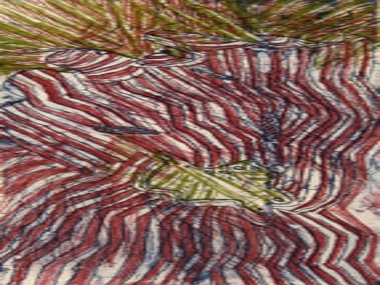RED OCHRE PRIZE GOES TO DOUGHTY FIGHTER

Red Ochre presenter Baz Luhrmann, Gawirrin Gumana and Dr Mark Bin Bakar, Chair ATSIAB (but better known as Ali G!)
Posted by Jeremy Eccles | 12.06.09
Yolgnu painter and rights campaigner Gawirrin Gumana AO was honoured with the most senior prize in Indigenous arts at the Australia Council's 2009 National Indigenous Arts Awards recently.
The $50,000 Red Ochre Award was presented by film director Baz Luhrmann, recognising Gumana’s distinguished contribution to Aboriginal and Torres Strait Islander arts at home and abroad. The Australia Council’s Aboriginal and Torres Strait Islander Arts Board Chair, Dr Mark Bin Baker, also paid tribute to Mr Gumana’s impressive career for seamlessly combining artistic excellence with his powerful spiritual and political concerns.
‘The Red Ochre Award celebrates the achievements of those who have fought to keep Indigenous culture strong. There can be no more worthy recipient than Gawirrin, who has been creating art in non-ceremonial contexts for more than 60 years - longer than any other living artist,’ he said.
‘As well as his art, Gawirrin’s contribution to his culture has been substantial and enduring – helping to secure land and sea rights for his people as well as working as a theologian and scholar. He joins a Who’s Who of eminent Indigenous artists to receive the Red Ochre Award, including Doris Pilkington Garimara, Jimmy Chi, Banduk Marika, Tom E Lewis, and the late Bob Maza and Justine Saunders,’ Dr Bakar said.
Gawirrin Gumana is the most senior living artist in North East Arnhem land. He is the oldest surviving artist who contributed to the Yirrkala Church panels in 1962/3 which proved the existence of a Yolgnu power structure that was not incompatible wirh Christian belief. They also asserted Yolgnu land rights against proposals by Nabalco to mine their land. The Panels then lead to the famous painted Bark Petition of 1963, sent to Canberra, which put Australians on notice of land claims predating European arrival in 1788.
The Bark Petition may still hang in Parliament House – but it failed to move the government of the day to change the law allowing miners to encroach. And the ensuing land rights law case – Millirpum v Nabalco – similarly affirmed Terra Nullius aginst the Yolgnu claims. Only last year in the great Blue Mud Bay case – technically Gawirrin Gumana &others vs. NT Government – was a victory achieved for the Yolgnu's absolute beliefs in their rights to local land.
Gawirrin’s paintings have been included in major local and international collections since 1966, and a great bark of his hangs in the Saltwater Collection in the National Maritime Museum after touring throughout 1999 and 2000. Gumana is quoted in the catalogue, saying “Within our rocks lies a sacred power deep inside. We can see it in our mind and hear stories about its existence.” His work was part of a massive response to the killing of a crocodile by poachers on a site sacred to the Ancestral crocodile, Baru, and is a detailed explanation of the forces that play on the waters in and around his land.
Gawirrin was awarded the Telstra National Aboriginal Art Award in 2002. A scholar in theological studies, Mr Gumana was ordained as a Minister of the Uniting Church in 1992. He lead his clan to the three famous dance festivals on Groote Eyelandt. His skills as an interpreter were pivotal to several political movements including the 1968 Supreme Court action and the homelands movement, where he led his clan back to their traditional Gangan country. At about 74 years of age he is still fighting on this issue – recently rejecting plans by the Federal and NT Governments to herd his people into townships rather than stay on their land.
URL: www.yirrkala.com
Share this:
»  del.icio.us
»
del.icio.us
»  Digg it
»
Digg it
»  reddit
»
reddit
»  Google
»
Google
»  StumbleUpon
»
StumbleUpon
»  Technorati
»
Technorati
»  Facebook
Facebook
Contact Details

'Garrapara' by Gawirrin Gumana 2008, an etching done in tribute to the Berndt crayon collection commissioned in Yirrkala in 1948.
Further Research
Artists: Gawirrin Gumana
News Tags: Australia Council | Baz Luhrmann | Gawirrin Gumana | Mark Bin Baker | Red Ochre Award | The Intervention | Yolgnu
News Categories: Reception
Exhibition Archive
- 10.10.17 | TARNANTHI 2017
- 11.08.17 | Natsiaas 2017
- 20.07.17 | APY ART DOMINATES THE WYNNE
- 17.07.17 | Anangu Artist Wins $100,000 Prize
- 14.07.17 | The End of AAMU
- 11.07.17 | ART ACROSS THE COUNTRY
- 11.07.17 | TARNANTHI IN OCTOBER
- 05.07.17 | TJUNGUṈUTJA - from having come together
- 13.06.17 | Ghost-Nets Straddle the World
- 07.06.17 | Grayson Perry Going Indigenous?
- 05.06.17 | Barks Bigger than Ben Hur
- 27.05.17 | NGA QUINQUENNIAL 2017
- 21.05.17 | Blak Douglas Finds Home at the NGA
- 21.05.17 | BRIAN ROBINSON WINS HAZELHURST WOP
- 18.05.17 | PARRTJIMA 2.0
Advertising

